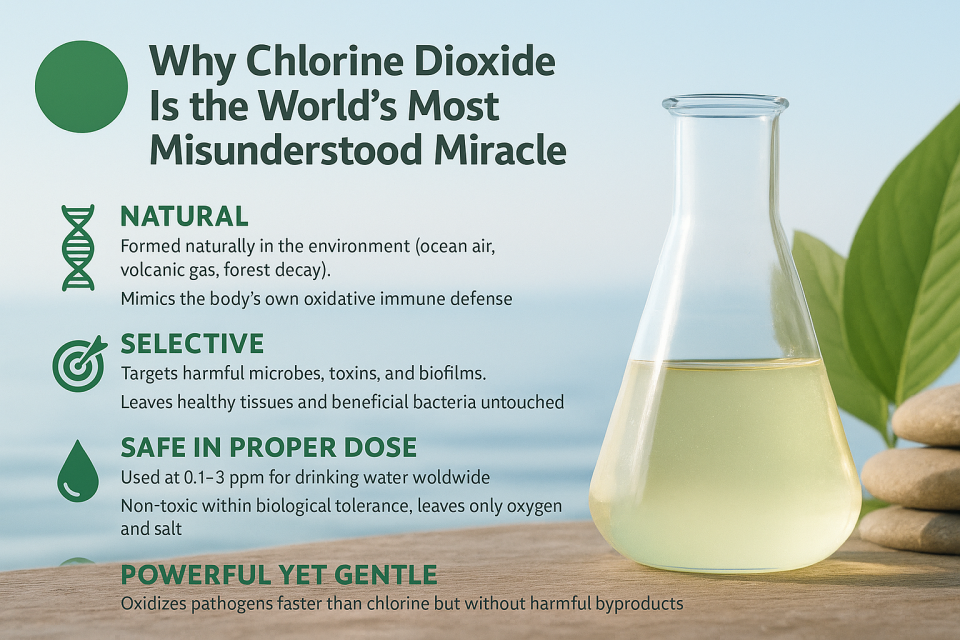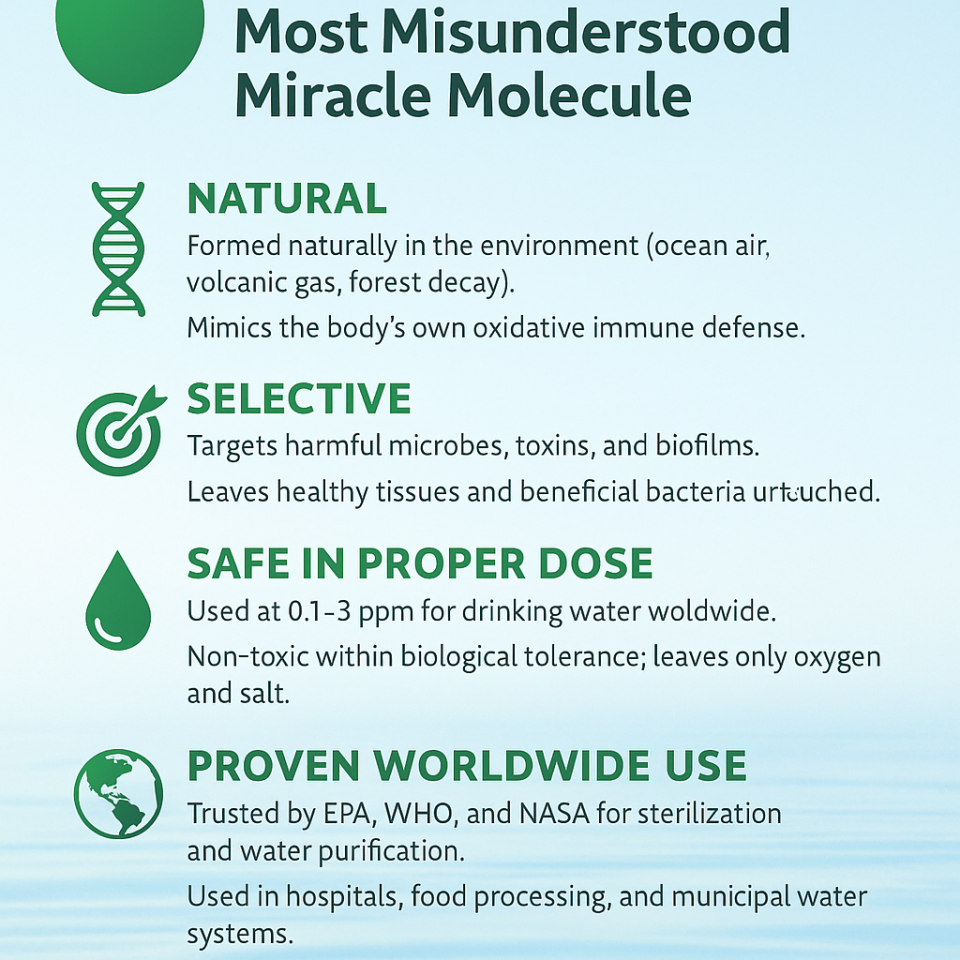For years, chlorine dioxide (ClO₂) has been misunderstood, mislabeled, and misrepresented by those who haven’t taken the time to study what it really is—or what it does. Some call it “toxic bleach.” Others call it the most powerful broad-spectrum antitoxin known to humankind. So, which is it? Let’s take a closer look at what chlorine dioxide really is and how it works.
The confusion starts with the word chlorine. Most people immediately think of pool chlorine or household bleach—both of which are indeed toxic and corrosive. But chlorine dioxide is not the same thing as chlorine or sodium hypochlorite (bleach).
Chemically, chlorine dioxide is a neutral molecule consisting of one chlorine atom and two oxygen atoms. It doesn’t chlorinate the body or form harmful byproducts like chlorine does. Instead, it acts as a selective oxidizer, meaning it targets and neutralizes harmful substances such as viruses, bacteria, fungi, and toxins—without harming healthy tissue when properly diluted and used responsibly.
In other words, chlorine dioxide doesn’t “burn” or “poison” the body—it oxidizes unwanted invaders and leaves behind nothing more than a trace of salt and oxygen.
Chlorine Dioxide Is a Natural Substance
Here’s something that surprises a lot of people: chlorine dioxide isn’t some synthetic lab invention—it’s a naturally occurring compound. In fact, nature itself produces oxidizers like chlorine dioxide in the atmosphere.
When sunlight interacts with ocean mist, volcanic gases, or the breakdown of certain organic materials, tiny amounts of chlorine dioxide and similar oxidizing compounds are formed naturally in the air. These substances play a vital role in keeping our planet’s air and water clean by neutralizing harmful microbes and toxins in the environment.
Inside the human body, the immune system uses a comparable oxidative defense mechanism. Our white blood cells create natural oxidants, such as hypochlorous acid and reactive oxygen species, to destroy pathogens. Chlorine dioxide works on that same principle—a natural oxidation process that supports purification and balance.
That’s why some researchers call chlorine dioxide a “bio-mimetic oxidizer”—it mimics the way nature purifies itself. It’s not foreign to life; it’s an extension of the same cleansing chemistry that keeps our air fresh, our water pure, and our bodies healthy.

Natural Origins & Planetary Role of Chlorine Dioxide
| Source / Environment | Natural Process Producing Chlorine Dioxide or Similar Oxidants | Resulting Function or Benefit |
| Ocean Mist & Sunlight | UV light reacts with sea salt aerosols containing chloride ions, forming trace chlorine oxides including ClO₂. | Purifies coastal air, neutralizes airborne microbes. |
| Volcanic Activity | Combustion gases and minerals react with atmospheric oxygen, creating reactive chlorine oxides. | Natural sterilization and detoxification of volcanic regions. |
| Forest Decomposition | Organic matter breakdown releases halogenated compounds that form oxidizers like chlorine dioxide. | Controls mold, decay, and odor in natural ecosystems. |
| Atmospheric Cleansing Cycle | Chlorine dioxide and ozone participate in oxidizing pollutants, restoring air balance. | Maintains the Earth’s self-cleaning system. |
| Human Immune System | White blood cells produce oxidants (e.g., hypochlorous acid, peroxides) that mirror ClO₂’s selective oxidation. | Neutralizes bacteria, viruses, and toxins inside the body. |
| Water Purification (Human Use) | Activated sodium chlorite mimics natural oxidative cycles to release pure chlorine dioxide gas. | Safely purifies water without harmful byproducts. |
Just as ozone (O₃) keeps our atmosphere clean, chlorine dioxide (ClO₂) helps maintain purity in both nature and applied human systems. It’s a natural ally, not an industrial villain.
Understanding Toxicity: It’s All About the Dose
Nearly every substance can be toxic—even water, oxygen, or vitamin D—if taken in excess. The word “toxic” has been thrown around without context when it comes to chlorine dioxide.
The truth is, chlorine dioxide has been safely used for decades in water purification systems, food sanitation, hospital sterilization, and even NASA space missions. Its ability to eliminate pathogens without producing toxic residues is precisely why it’s trusted in critical public health and environmental applications.
When properly diluted (for example, 1 to 3 ppm in water), chlorine dioxide is non-toxic to humans and animals but deadly to harmful microorganisms.
This makes it a dose-dependent ally, not a poison.
Comparative Toxicity and Safety of Common Oxidizers
| Substance | Purpose / Common Use | Approx. LD₅₀ (oral, rat) | Typical Safe Human Use Level | Relative Safety Notes |
| Water (H₂O) | Essential for life | ~90,000 mg/kg | 2–3 liters per day | Even water can be toxic in extreme excess (water intoxication). |
| Hydrogen Peroxide (H₂O₂) | Disinfectant, mouth rinse | ~800 mg/kg | 0.5–3% topical use | Mild oxidizer, but concentrated forms are caustic. |
| Household Bleach (NaOCl) | Cleaning agent | ~1,200 mg/kg | None (corrosive internally) | Highly toxic if ingested, irritant to tissues. |
| Chlorine Dioxide (ClO₂) | Disinfectant, water purifier | ~292 mg/kg | 0.1–3 ppm in water | Safe at low doses; used worldwide for drinking water. |
| Ethanol (Alcohol) | Beverage, antiseptic | ~7,000 mg/kg | Variable; 10–40 g typical | Safe in moderation; toxic in high concentrations. |
| Acetaminophen (Tylenol) | Pain reliever | ~338 mg/kg | 325–650 mg per dose | Overdose can cause fatal liver toxicity. |
LD₅₀ (Lethal Dose 50%) indicates the dose at which 50% of test animals perish. The smaller the number, the more toxic the substance. Notice that chlorine dioxide’s toxicity level is comparable to acetaminophen and hydrogen peroxide, yet at working concentrations (below 3 ppm), it is orders of magnitude safer—and unlike drugs, it leaves no toxic residue in the body.
How It Works as a Broad-Spectrum Antitoxin
Chlorine dioxide doesn’t mask symptoms or suppress immune responses. Instead, it acts like a cleanup crew in the bloodstream and tissues. Here’s what many advocates believe it does:
- Oxidizes harmful pathogens – including bacteria, viruses, and fungi, by targeting sulfur and nitrogen compounds they depend on.
- Breaks down biofilms – the slimy protective layers that pathogens hide behind, making infections chronic.
- Neutralizes toxins and heavy metals – through oxidation and structural breakdown, reducing the body’s toxic burden.
- Supports cellular oxygenation – because as it works, it releases oxygen molecules that can support overall metabolic health.
- Reduces inflammation – by clearing out microbial triggers that drive chronic inflammatory responses.
In this sense, chlorine dioxide functions as a broad-spectrum antitoxin, not by suppressing, but by cleansing the terrain of the body.
Comparing It to Common “Safe” Chemicals
Ironically, many over-the-counter products and medications accepted as “safe” carry far higher toxicity risks. Acetaminophen, for example, is responsible for thousands of liver failure cases annually.
Chlorine dioxide, when used correctly, has an extremely low toxicity profile—especially when compared to antibiotics, disinfectants, and even prescription antifungals.
If chlorine dioxide were as dangerous as detractors claim, it would not be approved by the EPA and WHO for drinking water purification in municipal systems worldwide.
A Question of Intent and Awareness
Calling chlorine dioxide “toxic” ignores the principle of dose, intent, and context. When used irresponsibly, yes—it can be harmful. But when handled correctly and applied with understanding, it becomes one of the most powerful tools available for cleansing and restoring balance in the human system.
It’s time we stop lumping chlorine dioxide into the same category as industrial bleach and instead recognize it for what it is: a controlled, intelligent oxidizer that nature itself seems to have designed for purification and renewal.
The Verdict
So—is chlorine dioxide toxic or the most powerful broad-spectrum antitoxin?
The honest answer is: it depends on how you use it.
At the right dose, in the right form, and for the right purpose, chlorine dioxide is one of the safest and most effective oxidizing agents ever discovered.
To those who’ve seen its results firsthand, it’s more than just a disinfectant—it’s a miracle molecule that restores cleanliness and vitality to the human body, one molecule of oxygen at a time.
Herb Roi Richards says, “If it’s strong enough to kill pathogens and gentle enough to purify our drinking water, maybe it deserves a second look.”
Perhaps chlorine dioxide isn’t toxic—it’s simply been misunderstood.


